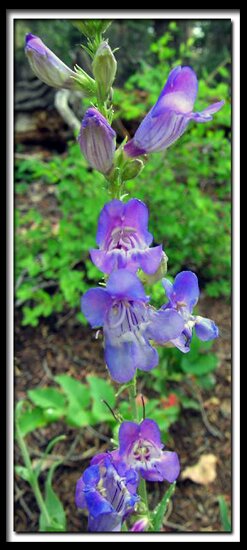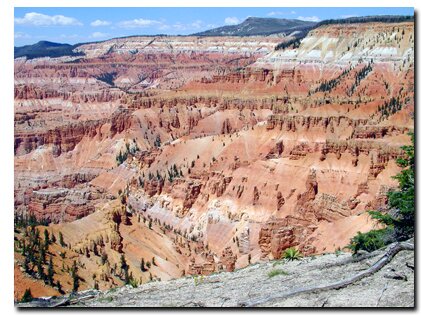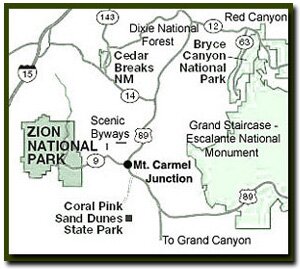 |
||||
|
Cedar Breaks Lodging Camping SR 148 SR-14 Hike Backpacking Vacation DNF Pictures Area Weather |
||||
|
|||||||||||||
Directions to Cedar BreaksU-148 Closure Dates. U-148 to Cedar Breaks closes in the winter due to snow depth. From Las Vegas: Take I-15 north to Cedar City. Take U-14 east from Cedar City to U-148 and turn left to Cedar Breaks. Cedar Breaks Road Map - Cedar Mountain Map 
|

|
|||
|
|
||||
Spectra Point - From the fenced viewpoint locate the trailhead sign for the Spectra Point Trail. Follow the mountain path for .8 miles as it skirts the rim to the southwest. There is a meadow to your left with evergreen trees mixed among a multitude of wildflowers. For those that love the simple beauty of flowers, Cedar Breaks is the place to go. One of the parks floral show stoppers is the delicate Colorado Columbine which can be seen along this trail. Views to the right of the path will steal your attention as millions of years of erosion unfold, showcasing spires in all sorts of peculiar sizes and shapes. The hoodoos are seen in various hues ranging from fiery orange to tangerine and even the lightest of pinks. The array of colors crammed into the large bowl delightfully contrast with the clear blue sky. Head up the hill toward the water tank, then immediately the route begins a steeper descent to Spectra Point, where a 270 degree view reveals a fantasy-land of geological formations including a few natural windows. See if you can find the oldest tree at Cedar Breaks. It is over 1,600 years old and it is found along this trail.
Ramparts Trail - There is an option at this point to turn around and retrace the .8 miles just hiked to arrive at Spectra Point or continue to the end of the Ramparts Trail, making the total hike about a 3 mile round-trip. If you choose to continue, follow the beaten path to the west, a little less than a mile, as it descends 330 feet. There are many new perspectives of the magnificent amphitheater below, and another amazing viewpoint at the end of the trail. The dirt path periodically skirts the rim as it descends the hillside through the ever more present Bristlecone pine trees. The ancient beauties at the end of the trail delight the senses along with a fresh view of the expansive chasm below filled with rugged rock sculptures rising from the pink sand. Return the same way you came.
Return the same way you came or it is possible to continue to Shooting Star Creek and Shooting Star Waterfall.
Utah's Dixie National Forest: Cedar MountainCedar Breaks National Monument is surrounded by Utah's Dixie National Forest. From Mt. Carmel Junction, drive north on US-89 to the junction with SR-14. SR-14 is known as Cedar Mountain which is the scenic byway to travel to Cedar Breaks. Once on Cedar Mountain, travel through the beautiful forest, and then turn at the signed highway to Cedar Breaks - SR-148. It's 22 miles from Mt. Carmel Junction to boundary of Dixie National Forest and 45 miles to Cedar Breaks.
Utah's Dixie National Forest: Red Canyon
Red Canyon is a unique part of Dixie National Forest that is not only traveled through on the way to Bryce Canyon, but it has eroded hoodoos like Bryce Canyon and Cedar Breaks. It is found along Scenic Byway 12.
|
|
Cedar Breaks National Monument, Utah
East Zion Lodge
Vacation House
Group Lodging
East Zion Golf
East Zion RV Park
Vacation Packages
Business Retreat
Mileage from
Mt. Carmel Jct.
Zion National Park 12
Bryce Canyon 60
Grand Canyon 85
Cedar Breaks 45
Grand Staircase 9
Dixie Forest 22
Sand Dunes 11
Coyote Butte 57
Red Canyon 47
Tuweep 90
Stay in the heart of the parks, Mount Carmel Junction, and visit the treasures of the Southwest and Utah.
Site Map
Site Map II
Site Map III
Hiking Trails
Bartizan Arch
Spectra Point Trail
Ramparts Trail
Easy Trails
Cascade Falls
Bristlecone Pine
Alpine Pond
Cedar Breaks info
Visitor Center
Fees and passes
Ranger programs
Kid activities
Geology
History
Fauna
Flora
"I don't know who Mary Cisneros is, but I mean zionnational-park.com
It's a better site than the NPS's anyway."
Written by the authors of the book: Favorite Hikes in and around Zion National Park
Contact Mary to report errors:
|
Zion History |
|---|
All rights reserved © Copyright Zion National-Park dot com
Do not use text, photos or maps without permission © Zion National-Park dot com
Contact the Author Mary Cisneros

 Cedar Breaks
Cedar Breaks


